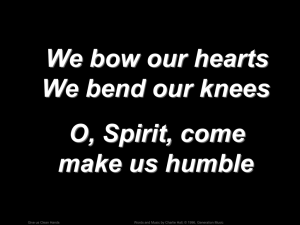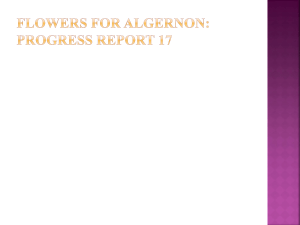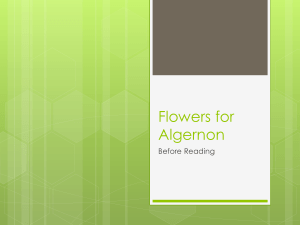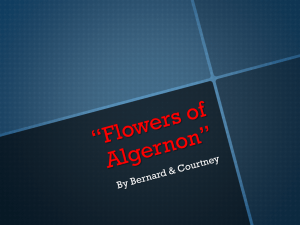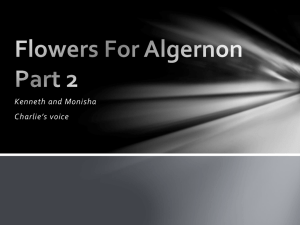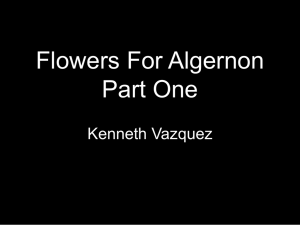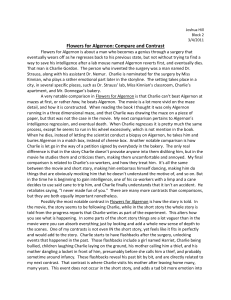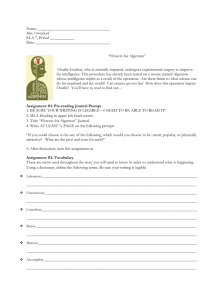flowers for algernon - notes
advertisement
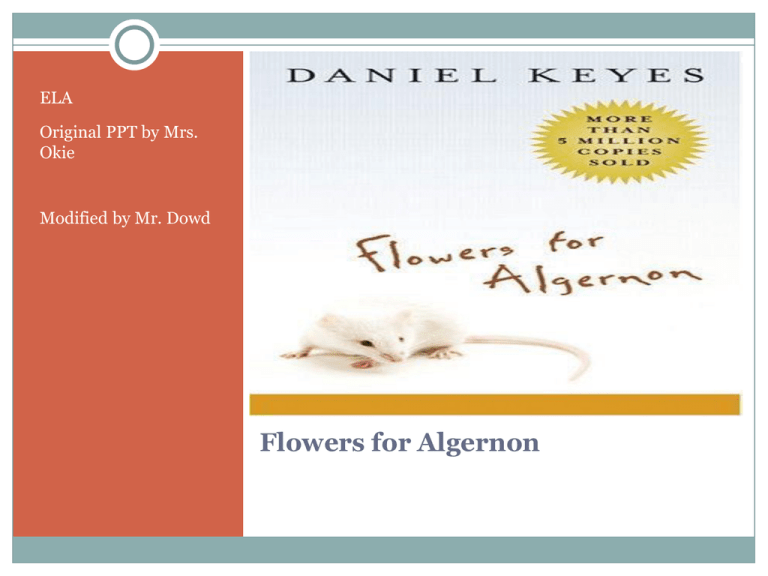
ELA Original PPT by Mrs. Okie Modified by Mr. Dowd Flowers for Algernon Genre: Science Fiction ● A broad genre of fiction that often takes place in the future and usually involves speculations based on current science. ● Commonly abbreviated as SF or Sci-Fi. ● Science fiction is found in books, art, television, movies, games, theater, and other media. Author: Daniel Keyes ● Born in 1927 in Brooklyn, New York City. ● American author, not primarily of science fiction. ● He is best known for his award-winning novelette “Flowers for Algernon” which he adapted into his same-name first novel (1966). Plot ● Charlie Gordon is a mentally handicapped man with an IQ of about 70. He is chosen to partake in a science experiment that will “make him smart.” There is a lot of growth that Charlie must go through (intellectually and emotionally) before discovering many truths about himself, the people around him, and his purpose in life. Structure ● Flowers for Algernon is unique in its structure. ● uses “progress reports” that Charlie is required to write as data for the experiment. ● The short story is written entirely from Charlie’s point of view and ● Contains memories, flashbacks, daily accounts of his learning and growth. Phonetic Spelling ● Phonetic spelling is spelling things the way that they sound. ● Example: “photograph” would be “fotograf”. ● Example 2: “great” would be “grate” or “gr8”. ● You’ll notice that in Flowers for Algernon, Charlie uses phonetic spelling. Themes/Motifs 1. Mistreatment of the Mentally Disabled: based on how society treats Charlie with his low IQ. In addition, it includes Charlie’s perspective of the disabled and how he continues to be treated after his operation. Themes/Motifs 2. Intellect vs. Emotion: Charlie’s situation certainly illustrates the difficulty of developing both intellect and emotion without conflict. The story also has characters that represent both “ends”: pure intellect and pure emotion. Themes/Motifs 3. Persistence of Past with the Present: As seen in Charlie’s recorded memories, the past consistently reveals itself and is a significant factor in Charlie’s perspective of the world. It also helps the reader to understand the person that Charlie is. Symbols 1. Algernon: The mouse that is Charlie’s laboratory “equal” and obviously represents Charlie on several levels. Algernon’s progress echoes Charlie’s. As well, Charlie feels, at times, more like a laboratory animal than a human being. Symbols 2. Window: Charlie recollects or feels that he is viewing the outside world through a window. It represents his emotional distance by watching the outside world through a barrier. Rorschach Test ● Psychology is the scientific study of mental processes and behaviour. ● Psychologists use exams to study different human activity, which may help them find the cause of problems in individuals’ daily lives so appropriate treatment of mental illness may be implemented. Rorschach Test Rorschach Test Ten faces in the tree? Multiple Intelligences ● Howard Gardner’s theory of multiple intelligences is a psychological and educational theory which suggests that many different kinds of “intelligence” exists in human beings. ● Each individual has different levels of these different intelligences. ● In other words, we all have different talents.
